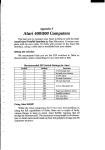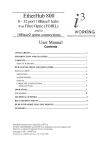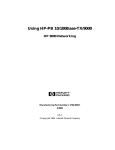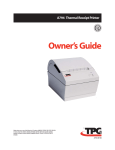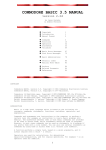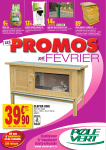Download HP C110 User's Manual
Transcript
C100_110-160_180.FB -1 Tue Jul 16 06:36:50 1996 Installing the C100/C110 to C160/C180 CPU Upgrade HP Part No. A4200-90017 E0796 Printed in USA C100_110-160_180.FB 0 Tue Jul 16 06:36:50 1996 Hewlett-Packard Co. 1996 Printing History First Printing: July 1996 UNIX is a registered trademark in the United States and other countries, licensed exclusively through X/Open Company Limited. NOTICE The information contained in this document is subject to change without notice. HEWLETT-PACKARD MAKES NO WARRANTY OF ANY KIND WITH REGARD TO THIS MATERIAL INCLUDING BUT NOT LIMITED TO THE IMPLIED WARRANTIES OF MERCHANTABILITY AND FITNESS FOR A PARTICULAR PURPOSE. Hewlett-Packard shall not be liable for errors contained herein or for incidental or consequential damages in connection with the furnishing, performance or use of this material. Hewlett-Packard assumes no responsibility for the use or reliability of its software on equipment that is not furnished by Hewlett-Packard. This document contains proprietary information that is protected by copyright. All rights reserved. No part of this document may be photocopied, reproduced or translated to another language without the prior written consent of Hewlett-Packard Company. RESTRICTED RIGHTS LEGEND. Use, duplication, or disclosure by government is subject to restrictions as set forth in subdivision (c) (1) (ii) of the Rights in Technical Data and Computer Software Clause at DFARS 252.227.7013. Hewlett-Packard Co., 3000 Hanover St., Palo Alto, CA 94304. 10 9 8 7 6 5 4 3 2 1 C100_110-160_180.FB 1 Tue Jul 16 06:36:50 1996 Upgrading your Model C100/110 to a Model C160 or C180 Upgrading your Model C100/110 to a Model C160 or C180 Your upgrade kit contains a Main Tray Assembly, which, when installed, upgrades your Model C100/110 to a Model C160/C180. NOTE: Installing this upgrade in your Model C100 or Model C110 does not affect the regulatory and safety classifications or approvals. The upgraded system meets all of the regulatory and safety standards listed in Appendix A of your original Model C100/110 Owner’s Guide. The following sections provide step-by-step instructions for removing the C100/110 main tray and power supply and installing the C160/C180 CPU main tray and power supply. The general steps are outlined as follows. See the individual sections for more detailed instructions. NOTE: The following steps must be followed in the order in which they appear. Refer to the individual sections of this guide for the actual step-by-step procedures for upgrading the C100/110 to a C160/180. • Update your operating system software to HP-UX 10.20. • Determine the LAN ID of your system. • Run the cclass_upgrade program. • Power off the workstation and any peripherals and unplug the power cords. Disconnect any peripheral cables and remove the floor stand. • Remove the main tray assembly. • Remove the memory boards from the CPU board and the option boards from the main tray and reinstall them onto the new main tray. • Place the main tray assembly into the workstation chassis. • Connect power cords and cables, restart the workstation, and enter the LAN ID when prompted. 1 C100_110-160_180.FB 2 Tue Jul 16 06:36:50 1996 Preparing Your Workstation Preparing Your Workstation Before starting the upgrade, use the following procedure to prepare the workstation: 1 The workstation must be running HP-UX 10.20 or later to accommodate the C160/C180 upgrade. If the workstation is running a version of HP-UX lower than 10.2, update the operating system software before continuing. 2 Determine the workstations LAN ID with the lanscan command by entering the following command: /usr/sbin/lanscan The output is similar to the following: Hardware Station Dev Hardware Net-Interface Path Address lu 2.0.2 0x08000970ECC0 0 NM Encapsulation Mjr State NameUnit State ID Methods Num UP lan0 ETHER 52 UP 4 After you install the new CPU board or I/O board and power on the system for the first time, you are prompted for the LAN ID. Record the information here so you have a record of it: EtherLAN ID ___________________-_____________________ You must supply the dash (-) between the first six digits and the last six digits. 3 Logout of your system and enter a no windows command line session as follows: HP VUE: At the login window, select Options, then select No Windows. HP CDE: At the login window, select Option, then select Command Line Login. 2 C100_110-160_180.FB 3 Tue Jul 16 06:36:50 1996 Preparing Your Workstation 4 Next, you need to run the upgrade utility program to automatically convert the hardware paths stored in the system’s I/O configuration file. You should only run this utility if you are going to complete the rest of the hardware upgrade described in this document. Enter the following command to run the upgrade utility program: /usr/sam/lbin/cclass_upgrade The upgrade utility prompts you to confirm that you want to continue, as follows: Are you ready to perform the upgrade (y/n [n] ) ? Enter Y. The upgrade utility proceeds to modify the I/O configuration information that is stored in the files /etc/ioconfig and /stand/ioconfig to be compatible with the upgraded system. The original I/O configuration information is saved in the backup file /etc/ioconfig.pre_upgrade. If the utility detects an A4077A Color Graphics Card or an A4078A Dual Color Graphics Card in the system, it will inform you to remove them when you perform the hardware portion of this upgrade. Systems with built-in Enhanced Graphics adapters do not support these optional graphics adapters. If you have a Visualize48Z (A4444A) graphics adapter installed, the utility may ask you to identify which slot the card set is installed in. Respond with the highest numbered option slot that the graphics adapter card set resides in. NOTICE: The cclass_upgrade utility modifies the hardware configuration so that it is incompatible with a C100 or C110 system. After running the utility, you must continue with this upgrade or restore the configuration information from /etc/ioconfig.pre_upgrade to /etc/ioconfig and /stand/ioconfig. 3 C100_110-160_180.FB 4 Tue Jul 16 06:36:50 1996 Preparing Your Workstation 5 If your system has an A4070B HCRX-8Z or an A4071B with the A4272A accelerator graphics adapter installed enter the following commands to save the current versions of the /etc/ioconfig and /stand/ioconfig files: mv /etc/ioconfig /etc/ioconfig.old mv /stand/ioconfig /stand/ioconfig.old 6 Power off your workstation by pressing the power button on the front panel. When you press the power button, the workstation automatically shuts down the operating system before it powers off the system. 7 When the workstation has completed shutting down and powering off, power off the monitor, and any peripheral devices connected to the workstation. If your system has supported graphics adapters installed, continue with step 8. Otherwise skip to step 12. 8 If a message to press Esc to stop the boot process is displayed, then press Esc. This stops the boot process and brings you to the Boot Console Handler prompt. 9 At the prompt, enter the following command to enter the information menu: in 10 Enter the followiong command to display the console setting: co The garphics path for the default console device is displayed. Make note of this information below for later use. Console Path: ________________________________________ 11 Power down the system. 4 C100_110-160_180.FB 5 Tue Jul 16 06:36:50 1996 Preparing Your Workstation 12 Unplug the power cord of the system unit, the monitor, and any peripheral devices from ac wall outlets. 13 Unplug the power cord from the back of the system unit. WARNING: To avoid electrical shock, make sure you unplug the power cable from the wall outlet and the system unit before proceeding any further. CAUTION: The internal components of your workstation are susceptible to mechanical and electrostatic shock. To prevent such damage from occurring, observe the following precautions during the installation procedure. • • Stand on a static-free mat Wear a static-grounding wrist strap to ensure that any accumulated electrostatic charge discharges from your body to ground. Attach the static-grounding wrist strap by following the instructions on the package that contains the strap. Be sure to attach one end of the strap to the system chassis. 5 C100_110-160_180.FB 6 Tue Jul 16 06:36:50 1996 Preparing Your Workstation 14 Remove the floor stand from the system unit, as shown in Figure 1. Figure 1 Removing the Floor Stand 15 Lay the system unit on a flat surface, such as a table top. 16 Attach a static-grounding wrist strap to bare metal on the back of the system unit. 6 C100_110-160_180.FB 7 Tue Jul 16 06:36:50 1996 Removing the Main Tray Assembly Removing the Main Tray Assembly Once you have prepared the workstation, you need to remove the main tray from the system unit, as described in the following procedure: 1 Completely loosen the four thumb screws on the rear of the system unit, as shown in Figure 2. Thumb Screws Thumb Screws Figure 2 Removing Main Tray Assembly 2 Place one hand on the top of the system unit and push, while pulling the handle on the rear panel with your other hand. See Figure 2. 3 Slide the main tray assembly out of the chassis. 7 C100_110-160_180.FB 8 Tue Jul 16 06:36:50 1996 Removing Memory Modules Removing Memory Modules After removing the main tray from the system, you must remove the memory modules from the original C100/110 CPU board, as described in the following procedure: 1 Locate the memory modules on the C100/C110 CPU board, as shown in Figure 3. Rear of Main Tray Memory Connectors Figure 3 Memory Module Location 8 C100_110-160_180.FB 9 Tue Jul 16 06:36:50 1996 Removing Memory Modules 2 Figure 4 To remove a memory module, push the ejector tabs on each side of the module. Lift the memory module up and out of the connector and place it on a static-free surface. Figure 4 shows how to remove a memory module. Removing a Memory Module 9 C100_110-160_180.FB 10 Tue Jul 16 06:36:50 1996 Removing Option Boards Removing Option Boards NOTICE: Any option boards that are supported by the new C160/180 system should be installed in the same slot number in the new main tray. If your C100/110 system has any option boards installed, you must remove them from the original C100/110 main tray, as described in the following procedure: 1 Figure 5 Press the fan release clip and rotate the fan, as shown in Figure 5. Rotating the Fan 10 C100_110-160_180.FB 11 Tue Jul 16 06:36:50 1996 Removing Option Boards 2 Slide the EISA slider to the side to remove it, as shown in Figure 6. 3 Remove the screw from the EISA retainer, as shown in Figure 6 4 Grasp the option board by the edge with both hands and pull it straight out from its slot. Repeat this step for each option board. 5 Set the option boards aside to be installed in the C160/C180 main tray. Option Board EISA Slider EISA Retainer Figure 6 EISA Slider Removing the EISA Slider and Retainer 11 C100_110-160_180.FB 12 Tue Jul 16 06:36:50 1996 Installing Memory Modules Installing Memory Modules Install the memory modules in the C160/C180 CPU board in the new main tray, as described in the following procedure: 1 Locate the memory connectors on the C160/C180 CPU board, as shown in Figure 7. The C160/C180 CPU has 12 memory slots, labeled 0A, 0B through 5A and 5B. The memory configuration is 32 MB to 768 MB installed in pairs of 16 MB, 32 MB, or 64 MB memory modules. Memory modules must be installed in pairs of equal capacity. Always install the largest capacity memory modules in the lowest numbered memory slots and don’t skip any numbers. For example, if you have a pair of 16 MB memory modules and a pair of 64 MB memory modules, first install the pair of 64 MB memory modules in slots 0A and 0B, then install the 16 MB modules in slots 1A and 1B. Figure 7 shows the positions of the memory connectors and slot numbering on the C160/C180 CPU board. Table 1 shows the memory configurations for the C160/C180 workstation. Rear of Main Tray 0A 4A 0B 4B 2A 5A 2B 5B 3A 1A 3B 1B Figure 7 C160/C180 Memory Connectors 12 C100_110-160_180.FB 13 Tue Jul 16 06:36:50 1996 Installing Memory Modules Table 1 Model C160/C180 Allowable Memory Configurations Config. No. Pair 0 Pair 1 A B Pair 2 A B Pair 3 A B Pair 4 A B A B 1 16 16 2 16 16 16 16 3 16 16 16 16 16 16 4 16 16 16 16 16 16 16 16 5 16 16 16 16 16 16 16 16 16 16 6 16 16 16 16 16 16 16 16 16 16 7 32 32 8 32 32 16 16 9 32 32 16 16 16 16 10 32 32 16 16 16 16 16 16 11 32 32 16 16 16 16 16 16 16 16 12 32 32 16 16 16 16 16 16 16 16 13 32 32 32 32 14 32 32 32 32 16 16 15 32 32 32 32 16 16 16 16 16 32 32 32 32 16 16 16 16 16 16 17 32 32 32 32 16 16 16 16 16 16 18 32 32 32 32 32 32 19 32 32 32 32 32 32 16 16 20 32 32 32 32 32 32 16 16 16 16 21 32 32 32 32 32 32 16 16 16 16 22 32 32 32 32 32 32 32 32 23 32 32 32 32 32 32 32 32 16 16 24 32 32 32 32 32 32 32 32 16 16 Pair 5 A B Total MB 32 64 96 128 160 16 16 192 64 96 128 160 192 16 16 224 128 160 192 224 16 16 256 192 224 256 16 16 288 256 288 16 16 320 13 C100_110-160_180.FB 14 Tue Jul 16 06:36:50 1996 Installing Memory Modules Table 1 Model C160/C180 Allowable Memory Configurations Config. No. Pair 0 Pair 1 Pair 2 Pair 3 Pair 4 Pair 5 A B A B A B A B A B 25 32 32 32 32 32 32 32 32 32 32 26 32 32 32 32 32 32 32 32 32 32 16 16 352 27 32 32 32 32 32 32 32 32 32 32 32 32 384 28 64 64 29 64 64 16 16 30 64 64 16 16 16 16 31 64 64 16 16 16 16 16 16 32 64 64 16 16 16 16 16 16 16 16 33 64 64 16 16 16 16 16 16 16 16 34 64 64 32 32 35 64 64 32 32 16 16 36 64 64 32 32 16 16 16 16 37 64 64 32 32 16 16 16 16 16 16 38 64 64 32 32 16 16 16 16 16 16 39 64 64 32 32 32 32 40 64 64 32 32 32 32 16 16 41 64 64 32 32 32 32 16 16 16 16 42 64 64 32 32 32 32 16 16 16 16 43 64 64 32 32 32 32 32 32 44 64 64 32 32 32 32 32 32 16 16 45 64 64 32 32 32 32 32 32 16 16 46 64 64 32 32 32 32 32 32 32 32 47 64 64 32 32 32 32 32 32 32 32 16 16 416 48 64 64 32 32 32 32 32 32 32 32 32 32 448 14 A B Total MB 320 128 160 192 224 256 16 16 288 192 224 256 288 16 16 320 256 288 320 16 16 352 320 352 16 16 384 384 C100_110-160_180.FB 15 Tue Jul 16 06:36:50 1996 Installing Memory Modules Table 1 Model C160/C180 Allowable Memory Configurations Config. No. Pair 0 Pair 1 Pair 2 A B Pair 3 A B Pair 4 A B Pair 5 A B Total MB A B A B 49 64 64 64 64 50 64 64 64 64 16 16 51 64 64 64 64 16 16 16 16 52 64 64 64 64 16 16 16 16 16 16 53 64 64 64 64 16 16 16 16 16 16 54 64 64 64 64 32 32 55 64 64 64 64 32 32 16 16 56 64 64 64 64 32 32 16 16 16 16 57 64 64 64 64 32 32 16 16 16 16 58 64 64 64 64 32 32 32 32 59 64 64 64 64 32 32 32 32 16 16 60 64 64 64 64 32 32 32 32 16 16 61 64 64 64 64 32 32 32 32 32 32 62 64 64 64 64 32 32 32 32 32 32 16 16 480 63 64 64 64 64 32 32 32 32 32 32 32 32 512 64 64 64 64 64 64 64 65 64 64 64 64 64 64 16 16 66 64 64 64 64 64 64 16 16 16 16 67 64 64 64 64 64 64 16 16 16 16 68 64 64 64 64 64 64 32 32 69 64 64 64 64 64 64 32 32 16 16 70 64 64 64 64 64 64 32 32 16 16 71 64 64 64 64 64 64 32 32 32 32 72 64 64 64 64 64 64 32 32 32 32 256 288 320 352 16 16 384 320 352 384 16 16 416 384 416 16 16 448 448 384 416 448 16 16 480 448 480 16 16 512 512 16 16 544 15 C100_110-160_180.FB 16 Tue Jul 16 06:36:50 1996 Installing Memory Modules Table 1 Model C160/C180 Allowable Memory Configurations Config. No. Pair 0 Pair 1 Pair 2 Pair 3 Pair 4 Pair 5 Total MB A B A B A B A B A B A B 73 64 64 64 64 64 64 32 32 32 32 32 32 74 64 64 64 64 64 64 64 64 75 64 64 64 64 64 64 64 64 16 16 76 64 64 64 64 64 64 64 64 16 16 77 64 64 64 64 64 64 64 64 32 32 78 64 64 64 64 64 64 64 64 32 32 16 16 608 79 64 64 64 64 64 64 64 64 32 32 32 32 640 80 64 64 64 64 64 64 64 64 64 64 81 64 64 64 64 64 64 64 64 64 64 16 16 672 82 64 64 64 64 64 64 64 64 64 64 32 32 704 83 64 64 64 64 64 64 64 64 64 64 64 64 768 16 576 512 544 16 16 576 576 640 C100_110-160_180.FB 17 Tue Jul 16 06:36:50 1996 Installing Memory Modules 2 To install a memory module, close the ejector tabs on each side of the memory connector and line the memory module up with the guides, as shown in Figure 8. Make sure that the notched end of the memory module is toward the white ejector tab, or to the rear of the main tray, as shown in Figure 8. White Ejector Tab Figure 8 Installing a Memory Module 3 Press firmly and evenly on the memory module to ensure that it is fully seated. 17 C100_110-160_180.FB 18 Tue Jul 16 06:36:50 1996 Installing Option Boards Installing Option Boards NOTICE: Any option boards that are supported by the new C160/180 system should be installed in the same slot number in the new main tray that they were installed in the old main tray. If you are installing a graphics adapter, read and understand the information in the next section titled “Graphics Adapter Considerations”, before continuing. Otherwise skip to the subsection titled “Option Board Installation”. Graphics Adapter Considerations If you are installing a graphics option, read the information in this section first. Graphics Paths graphics(0) is the built-in 8-plane graphics adapter. graphics(1) through graphics(4) are graphics adapters installed in option slots 1 through 4. When a dual display graphics adapter (an adapter which has two video output connectors) is installed, the video connector on the left (when looking at the system from the rear) is graphics(NA), and the video connector on the right is graphics(NB), where N is the slot number in which the graphics adapter is installed. For example, a Dual Visualize Enhanced Graphics Card (A4451A) installed in option slot 3 would be graphics3A and graphics3B. 18 C100_110-160_180.FB 19 Tue Jul 16 06:36:50 1996 Installing Option Boards Graphics Configuration Restrictions The system supports only four graphics displays at a time. A “display” is a video output port or connector. For example, the Dual Visualize Enhanced Graphics Card (A4451A) is a dual display card. It has two external video connectors so it accounts for two of the maximum of four displays. If you installed two of these cards, they would account for the maximum of four displays supported by the system. The built-in graphics adapter accounts for one graphics display (graphics0). If four displays are installed in the option slots, the built-in graphics adapter is automatically disabled. You may not install a dual display graphics adapter in option slot 1 and option slot 3 at the same time. If you do, the graphics adapter in slot 1 will be disabled. You may not install a dual display graphics adapter in option slot 2 and option slot 4 at the same time. If you do, the graphics adapter in slot 2 will be disabled. When a Visualize48Z (A4244A) two board graphics adapter is installed, Only one other graphics adapter may be installed in the option slots. If the highest numbered slot used by the Visualize 48Z board set is an even numbered slot, then you may only install a graphics card in the remaining odd numbered slot. If the highest numbered slot used by the Visualize 48Z board set is an odd numbered slot, then you may only install a graphics card in the remaining even numbered slot. For example, with the Visualize 48Z board set installed in slots 1 and 2, slot two is the highest numbered slot used and it is an even numbered slot. Therefore you may only install an additional graphics adapter in slot 3, which is the remaining odd numbered slot. NOTICE: The A4077A Color Graphics Card, A4078A Dual Color Graphics Card, A4079B HCRX-8Z graphics adapter and the A4071B HCRX-24 graphics adapter with the A4072A Z Accelerator attached are not supported in the Model C160/C180. 19 C100_110-160_180.FB 20 Tue Jul 16 06:36:50 1996 Installing Option Boards Option Board Installation If you removed option boards from the C100/110 main tray, use this procedure to install them in the new C160/C180 main tray. Otherwise, skip to the next section. 1 Figure 9 Press the fan release clip and rotate the fan, as shown in Figure 9. Rotating the Fan 20 C100_110-160_180.FB 21 Tue Jul 16 06:36:50 1996 Installing Option Boards 2 Remove the screw from the EISA retainer, and remove the EISA retainer, as shown in Figure 10. Eisa Slider Eisa Retainer Figure 10 Removing the EISA Retainer and EISA Slider 3 Remove the EISA slider, as shown in Figure 10. 21 C100_110-160_180.FB 22 Tue Jul 16 06:36:50 1996 Installing Option Boards 4 NOTE: In the desired option slot, turn the blank plate’s locking knob counter-clockwise to unlock the plate, as shown in Figure 11. The new main tray assembly contains a blank plate which is held in by a locking knob. Be sure to remove these components before attempting to install the option boards. Locking Knob Blank Plate EISA Slider Figure 11 Removing a Blank Plate 5 22 Remove the blank plate from the slot, as shown in Figure 11. C100_110-160_180.FB 23 Tue Jul 16 06:36:50 1996 Installing Option Boards 6 Figure 12 Slide the option board into the slot. Make sure that the hole in the board’s handle aligns with the pin on the back panel, as shown in Figure 12. Installing an Option Board 7 Press in firmly on both ends of the option board at the same time to make sure that it is firmly seated in the backplane connector. 23 C100_110-160_180.FB 24 Tue Jul 16 06:36:50 1996 Installing Option Boards 8 Replace the EISA retainer and its screw, as shown in Figure 13. 9 Replace the EISA slider, as shown in Figure 13 EISA Slider EISA Retainer EISA Retainer Figure 13 Installing the EISA Retainer and EISA Slider 24 C100_110-160_180.FB 25 Tue Jul 16 06:36:50 1996 Installing Option Boards 10 Rotate the fan back into place and firmly push it into the rear panel firmly until the clip snaps into place, as shown in Figure 14. Figure 14 Securing the Fan 25 C100_110-160_180.FB 26 Tue Jul 16 06:36:50 1996 Installing the New Main Tray Assembly Installing the New Main Tray Assembly Install the new C160/C180 main tray assembly, as described in the following procedure: 1 Align the main tray assembly with the chassis and slide it into place, as shown in Figure 15. Thumb Screws Thumb Screws Figure 15 NOTICE: Installing the New Main Tray Assembly 2 Slide the main tray in until you feel it make contact with the internal connectors. 3 Push firmly and evenly on the main tray assembly to make sure that all connectors are fully seated. 4 Start all four thumb screws loosely, then tighten them firmly. See Figure 15. To maintain regulatory agency compliance, verify that the main tray is fully seated and all four thumb screws are completely tightened. 26 C100_110-160_180.FB 27 Tue Jul 16 06:36:50 1996 Installing the New Main Tray Assembly 5 Remove any external SCSI terminators from the rear of the old main tray and install them on the SCSI connectors on the rear of the system. 6 Use a small flat blade screwdriver to gently pry the old model number label from the front of the system. Remove the backing from the new C160/180 model number label that came with the upgrade, and press it firmly into place. Model Number Label Figure 16 Installing the Model Number Label 27 C100_110-160_180.FB 28 Tue Jul 16 06:36:50 1996 Installing the New Main Tray Assembly 7 Figure 17 Replace the system unit in the floor stand, as shown in Figure 17. Installing the Floor Stand 28 C100_110-160_180.FB 29 Tue Jul 16 06:36:50 1996 Installing the New Main Tray Assembly 8 Reconnect the power cables and any other cables that you disconnected when opening the workstation. If you do not have a supported graphics adapter, connect your monitor’s 15-pin connector to the 15-pin connector on the EVC adapter cable which came with the upgrade kit. Connect the other end of the EVC adapter cable to the built-in video connector on the rear of the system. Be sure to tighten the thumbscrews on the connectors. Continue with step 9. If you do have a supported graphics adapter, connect the 15-pin monitor connector directly to the connector on the graphics adapter. Skip to step 19. 9 Power on the monitor, the system, and any peripherals. 10 If your keyboard connects to the PS/2 connector on your system, wait 2 seconds after the Num Lock light flashes near the end of the boot sequence, then press Tab to initiate the automatic monitor selection process. NOTICE: It takes approximately one to two minutes after powering on the workstation before the Num Lock light flashes. If you have a keyboard that connects to the HIL connector on your system, press Tab every three seconds during the boot sequence to initiate the automatic monitor selection process. 29 C100_110-160_180.FB 30 Tue Jul 16 06:36:50 1996 Installing the New Main Tray Assembly 11 The system cycles through all of the available monitor types one at a time. When you can see a message similar to the following clearly and litigable, select that monitor type by pressing Enter. MONITOR INFORMATION Path Slot Head Type Size Freq Class ----------- ---- ---- ---- ---------- ---- ----- GRAPHICS(0) 0 1 n nnnnxnnnn MHz Press [RETURN] to select this monitor type (type n of n types). 12 The system queries you to confirm your selection. Press Y to save this monitor type. If you press any key other than Y, the following message is displayed: Monitor type not saved. If you didn’t press Y, the new monitor type is active, but not saved. Because you didn’t save the monitor type, the next time you reboot the system the original monitor type will be used. Next, the following message is displayed: To select a new Graphics Monitor Type press the <TAB> key now, otherwise EXIT by entering any other key (or will time out in 15 seconds)... To restart the monitor selection process, press TAB. If you do not have a (supported) graphics adapter installed in slot 3 or slot 4 continue with step 13. Otherwise skip to step 19. 13 After choosing and saving your monitor type, the following message is displayed: To select a new Graphics Monitor Type press the <TAB> key now, otherwise EXIT by entering any other key (or will time out in 15 seconds)... Either wait fifteen seconds for the boot process to continue, or press any key except TAB. 14 If a message to press Esc to stop the boot process is displayed, then press Esc. This stops the boot process and brings you to the Boot Console Handler prompt. 30 C100_110-160_180.FB 31 Tue Jul 16 06:36:50 1996 Installing the New Main Tray Assembly 15 At the prompt, enter the following command to enter the configuration menu: co 16 Configure the console path for the built-in graphics with the following syntax: mo graphics(0) 17 Power off the system. 18 Power on the system. After you install a new CPU board or I/O board and boot the system for the first time, you are prompted for the LAN ID. Enter the LAN ID you recorded in the beginning of this document. Skip to step 25. 19 Power on the monitor, any peripheral devices, and the system unit. 20 If a message to press Esc to stop the boot process is displayed, then press Esc. This stops the boot process and brings you to the Boot Console Handler prompt. 21 At the prompt, enter the following command to enter the configuration menu: co 22 Configure the console path for your graphics adapter with the following syntax: mo graphics(n) where graphics(n) is the graphics path that you recorded earlier. 23 Power off the system. 24 Power on the system. After you install a new CPU board or I/O board and boot the system for the first time, you are prompted for the LAN ID. Enter the LAN ID you recorded in the beginning of this document. 25 Pack the old main tray in the packaging from the upgrade kit and use the documentation provided to return it to Hewlett-Packard. 31 C100_110-160_180.FB 32 Tue Jul 16 06:36:50 1996 Installing the New Main Tray Assembly 32







































